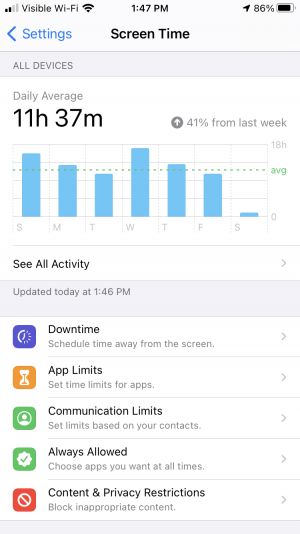Screen time's effect on adolescents mental health
Screen time is the aggregate time spent using a device with a digital screen, which can include computers, smartphones, tablets, TV's, and video games. There are five different categories of screen time: social, passive, interactive, educational, and other[ref], and all five categories in excess show negative psychological effects. It is measured in hours per day. Mental Health is defined by the World Health Organization as a state of well-being whereby individuals recognize their true abilities, are capable of coping with the normal stresses of life, and are capable of productively and joyfully contributing to their communities. The effects of screen-time on young users' mental health is an emerging area of research of the 21st century. Adolescents 18-29 comprise the highest proportion of smartphone users, making up 96% of the market share of mobile phone ownership. Studies show that excessive mobile screen time is significantly associated with depressive symptoms. The true extent to which screen-time affects mental health is still being researched, which could inform decisions on regulation.
PHYSICAL HEALTH
Screen time has been proven to have a negative linear relationship with physical activity, which is a key attribute in mental health. Physical activity boosts confidence, lessens depression and anxiety, and improves sleep quality. Children who watched TV for a long period of time demonstrated reduced participation in physical activities. In a survey of Iranian students, those who were categorized as having high screen time usage of over 2 hours per day and the low level of physical activity of exercising 1-2 days per week were independently associated with self-reported psychological distress by reporting symptoms of depression, anger, insomnia, worthlessness, confusion, anxiety and worry. In the same study, students with high physical activity and high screen time reported less psychological distress than students with high screen time and moderate physical activity, suggesting that physical activity can improve psychological well-being irrespective of screen time.
High screen time also increases the chance of engaging in unhealthy behaviors that harm the physical body, such as consuming fattening food, smoking, drinking alcohol, using tobacco, and leading a life of inactivity. Inactivity is linked to psychological disorders, including anxiety and depression. There is an indirect link between screen-time and worser mental health due to the physical repercussions.
PSYCHOLOGICAL SYMPTOMS
-depression and anxiety
THEORIES OF USE -compulsory -comparative
5 TYPES
describe w effects
REGULATION -parents? self-regulation?
MODERATION Moderate amounts of electronic screen time are associated with higher mental well-being compared to low or high levels Goldilocks effect proven good sometimes
